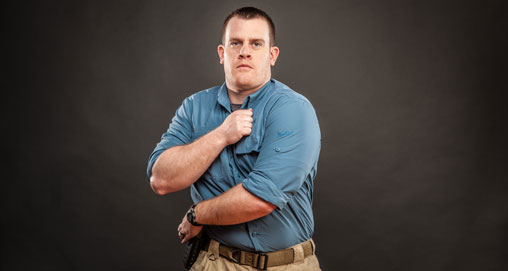
7/1/2013
Once a shooter has developed some skill in the basics of defensive shooting, it is time to learn to shoot with the support hand. There can be many reasons for needing to return fire with the support hand. The strong hand may have been injured and no longer has the strength to manipulate the handgun, or the strong hand may be engaged in holding on to something, or someone. And it is also possible that the attacker may have grabbed hold of the strong hand in order to prevent the defensive shooter from getting a handgun into action.
Support-hand shooting begins with a look at the defensive holster. The holster should be of a design that allows the shooter to reach a handgun with either hand. Even if the holster is carried on the strong-side hip, the shooter should be able to reach behind the back, or across the front (whichever is easiest) and get the handgun into action. For this reason, the location that the holster is worn, and any safety straps or devices, should be considered when holster selection is being made. This is one of the reasons that I prefer an open-topped holster, without thumbsnaps or other locking devices, for concealed carry.
Drawing the handgun with the support hand is a relatively slow proposition regardless of where the handgun is worn. However, dry practice will allow the defensive shooter to develop a smooth, if not fast, support-hand presentation. Be sure to practice this draw stroke with an unloaded handgun. In fact, it's best to remove all of the ammunition from the room where practice is being conducted. Check and double check the handgun to make sure it is actually unloaded. And, once you have left the practice area and reloaded the handgun don't fall into the trap of trying one more presentation. When dry practice is over, it is over, period.
Whether a person reaches behind the back or across the front to get a shooting grip on the handgun depends upon individual build and arm length. If it can be accomplished, reaching behind the back is to be preferred because a person can get somewhat of a shooting grip on the handgun immediately. As the gun is being drawn across the back, special attention should be given to make sure that the gun is slightly canted, with the muzzle pointed away from the body. If the pistol has a thumb safety, the index finger can be used to disengage the safety as the muzzle is being indexed toward the threat.
If the shooter has to reach the handgun from across the front of the body he or she will generally end up with the gun in an upside down hold. It must then be held against the body for a proper shooting grip to be obtained. Obviously, the chance of fumbling the handgun, or even dropping it, is much greater. Still, for some folks, that is the only way to get the handgun from the holster into the support hand. In this case, even more dry practice is required to develop the skill to a useful level.
Since the support hand is being used because the strong hand is disabled, or otherwise occupied, the shots are delivered one handed. However, this does not call for point shooting. The handgun should still be held at eye level and the sights used, just as in two-handed shooting. The arm should be almost straight without locking the elbow. The front sight should be clearly in focus as the shots are delivered.
Some find that by canting the handgun slightly inward the wrist is locked and recoil can be managed a bit better. We are not talking about the “Gangster Hold,” where the handgun is turned on its side. The handgun is canted only slightly, just enough to lock the wrist and manage the recoil.
Even though the shooter is using the support hand, he or she should make every effort to sight with the dominant eye. For most shooters, the dominant eye is on the strong side of the body. Simply cocking the head slightly toward the support side will allow the use of the dominant eye.
Obviously, a person is not going to be very fast when shooting with the support hand. And a good deal of practice is required in order for the movements to become smooth. However, smooth is what a person should work to obtain. And the vast majority of that practice should be dry practice, with an unloaded handgun, to avoid fumbling the gun and having a negligent discharge.
Finally, support-hand shooting is not a fast-draw technique so much as it is a survival technique. It allows the defensive shooter to stay in the fight. And, by staying in the fight, he or she has a chance to win that fight.





































